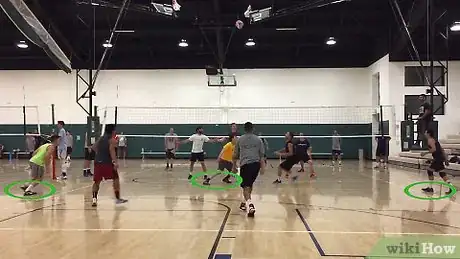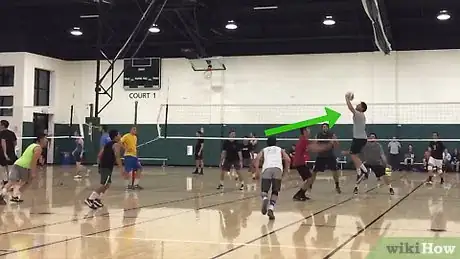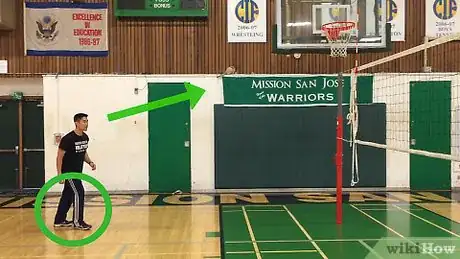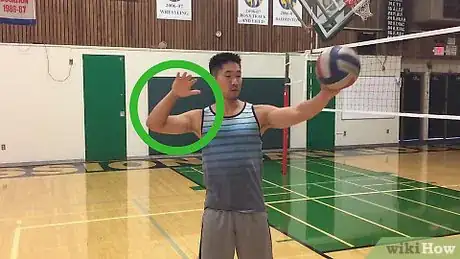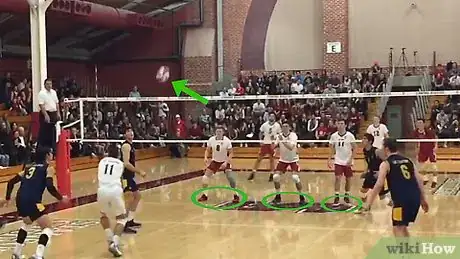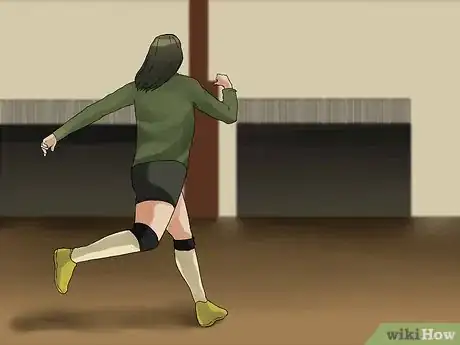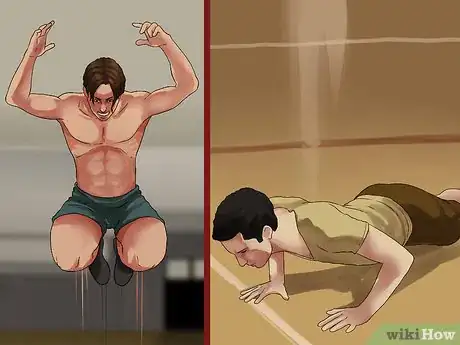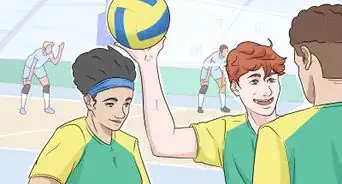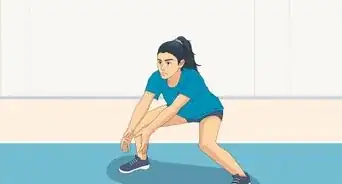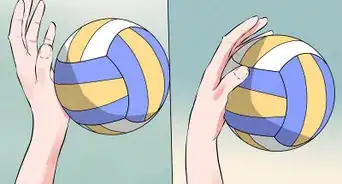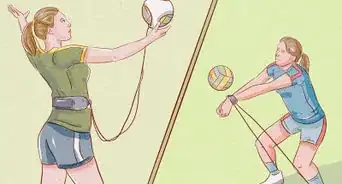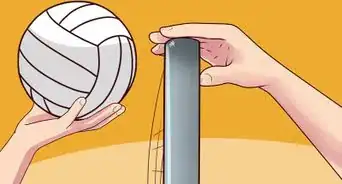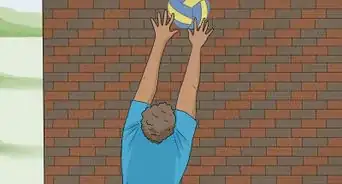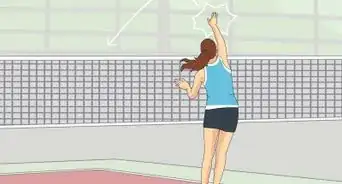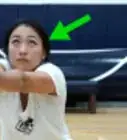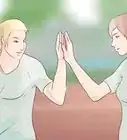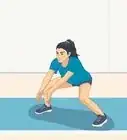wikiHow is a “wiki,” similar to Wikipedia, which means that many of our articles are co-written by multiple authors. To create this article, 106 people, some anonymous, worked to edit and improve it over time.
wikiHow marks an article as reader-approved once it receives enough positive feedback. This article received 16 testimonials and 85% of readers who voted found it helpful, earning it our reader-approved status.
This article has been viewed 1,083,941 times.
Learn more...
Spiking a volleyball entails forcefully striking the ball toward the floor on your opponent's side of the net. You wait for the setter to set the ball near the net, then approach the ball, jump, and go in for the "kill." If the ball hits the floor before the other team can retrieve it, your team gets a point. After learning the fundamentals of spiking, practice alternate approaches and work on increasing the power of your spikes.
Steps
Spiking Basics
-
1Get into position. The rules of volleyball state that in order to strike the ball over the net, you must be a front row player. It's most effective to strike the ball from the right or left side at a sharp downward angle. Whether you are spiking the ball from the right or left front position, position yourself behind the 10-foot line (attack line), which is the line that is about four steps away from the net.
- If you have long legs or take bigger steps, and stand further back.
- If you are right handed, you may have a more powerful spike when you approach from the left side of the court, and vice versa if you are left handed. If you are tall or can jump higher, try starting near the middle.
-
2Watch the setter. The person playing the center position will set the ball high in your direction, arcing it so that it falls close to the net in a position that makes it easy to spike it to the other side. You'll start your approach after the ball is set.
- As you practice spiking, make sure you're working with a skilled setter. It should rise and fall in a gentle arc close to the net, putting it in the perfect position for you to go in for the kill.
- As you practice with your team, you'll want to call to your teammates to let them know you're striking. Many teams come up with codes for each side, so use them if yours does.
Advertisement -
3Assume the correct stance. Face the ball and bend your knees so you're ready to move. If you're right-handed, your left foot should be set back from your right foot. If you're left-handed, your right foot should be set back from your left foot.
-
4Take your first step toward the ball. Take a strong first step with your left foot in the direction of the ball. If you're left-handed, do the reverse.
-
5Take a second powerful step. Step with your right foot to build speed (if you're left-handed, it will be your left foot). At the same time, swing your arms back behind you to prepare for the strike. The distance of this second step will vary according to the position of the ball. If the ball is closer to you, you'll take a short step; if it's further from you, take a longer step.[1]
-
6Take a final step to square your feet. Step again with your left foot (or your right, if you're left-handed) and end with your feet shoulder-width apart and your knees bent. Your arms should be swung back behind you.
- Your arm swing is essential when it comes to the height of your jump. A well-timed swing will help your upward momentum. Practice getting the timing down perfectly.
- Make sure your feet are shoulder-width apart so you don't end up off balance.
- Keep your head up to watch the ball as it falls toward you.
-
7Jump as the ball falls into position. As your last step lands, your body should be turned at 30 degrees from the net with your hitting shoulder further from the net. Jump explosively upward and swing your arms forward at the same time to jump high into the air. The higher you jump, the more powerful your strike will be.
-
8Rear your hand back to strike. As you reach the height of your jump, your arms should swing above your head. Pull back your right elbow (or your left, if you're left-handed) and bend it at a ninety degree angle. Your hand should now be at head level.
-
9Hit the ball with the center of your hand. Keep your hand open with your fingers together. Rotate your arm at the shoulder and whip your forearm forward to move your hand quickly toward the ball and make contact. Snap your wrist downward to impart topspin and direct the ball down into your opponent's court.
- Try to hit the ball at the height of your jump to maximize the power of your strike.
- Bring your arm down "through" the ball and next to your body. This ensures that you don't lose momentum throughout your hit.
- It's against the rules to touch the net. Bring your arm back toward your body after the strike to avoid a penalty.
- Be careful not to "carry" or "hold" the ball for even a second, as this is against the rules.
-
10Bend your knees when you feet hit the ground. This will help you regain balance and avoid an ankle injury. Make sure you don't fall into the net as you land.
-
11Get back into position. If the opposing team returns the ball, you'll need to be ready for more action. Drop back from the net and get in your ready position. Keep your eye on the ball the whole time.
Increasing Your Power
-
1Practice your footwork without the ball. When you're just learning how to spike, it's important to get the footwork down. Practice enough that you know the volleyball approach well enough to do it in your sleep. Remember to start behind the attack line and move toward the imaginary ball. Focus on mastering a fast, powerful approach.
-
2Practice swinging as hard as you can. Take a volleyball and practice hitting it against a wall, over and over. Toss it up in the air or set it to yourself, then practice rearing back and spiking. Remember to snap your forearm forward by bending your elbow and rotating it toward the ball. The more quickly you can do this, the more powerful your spikes will be.
- Practicing on your own is good, but it also helps to work with a partner who can set the ball for you so you can work on your entire approach, jump and swing.
- Focus on making solid contact with the ball, snapping your wrist and following through.
-
3Increase the height of your jump. The height of your jump is reliant on your entire approach, not just the final step. Make sure you step toward the ball powerfully to begin building momentum. Swing your arms back briskly as you bend your knees. When you jump, your entire body should move in one upward swing, putting you in the best possible position to spike the ball.
- Practice jumping as high as you can and spiking the ball at the height of your jump every time.
- Try working with a spike trainer. This is a device that holds the ball in a high position, forcing you to jump high enough to hit it at the height of your jump and spike it out of the device.
-
4Get your timing down. Knowing exactly when to hit the ball can really impact the power of your spike. You want to time your approach so that you're able to make contact with the ball right as it reaches your "sweet spot," the place where your hand can strike it downward while you're still at the height of your jump. Timing is one of the most skills to master; only with plenty of practice will you be able to maximize your strike.
- To work on your timing, it helps to practice with a good setter. Work with someone who is capable of setting the ball high and in the correct position for you to strike it at the top of your jump.
- Keep your eye on the ball as you approach for the strike. If you hit it with the tips of your fingers or too low on your hand, you know your timing was off.
-
5Always follow through. Follow through is essential for a powerful strike, because without it, you're forced to halt your hand's momentum before it has had the chance to really attack the ball at full speed. The key is to follow through without touching the net. Bend your elbow during your follow through so you can keep your arm close to your body instead of reaching into the net.
-
6Do strength training exercises. Serious volleyball players do special exercises in order to build up the calves, abs, rotator cuff muscles and other muscles that allow them to jump powerfully into the air. Work with your coach to start an exercise routine that will help you jump higher. Here are a few exercises to try:
- Do push ups. You can either start with your hands placed on the ground or on an exercise ball, which also helps your shoulder stability. Do three sets of fifteen pushups each, increasing reps as you gain strength over time.[2]
- Do a two-hand overhead ball slam. Use a medicine ball (a heavy volleyball-sized ball). Standing with your feet shoulder-width apart, use both hands to swing it up over your head, then slam it down on the ground. This works out your shoulders and arm muscles.[3]
Making the Kill
-
1Work on the angle of your strike. A strike is more powerful and effective when you hit the ball at a sharp downward angle. You want it to hit the floor as quickly as possible, so your opponent won't have time to return it. Once you've mastered the correct striking form, practice striking at a sharp angle.
- Look for the holes in the court that your opponents will have trouble reaching. Aim for the holes instead of striking the ball directly to the opponents.
- By striking from different places along the net, you can take advantage of your opponents' weak spots.
- Practice your aim by hitting on a box. Stand on a tall, sturdy box in the position you would be in at the height of your jump during a spike. Have someone set the ball to you and practice spiking it from the box to hit targets on the other side of the net.[4]
-
2Learn to see blockers. Blockers are players on the opposing team whose job it is to block your spike from getting over the net. No matter how powerful you strike the ball, if you plow it right into a blocker, you probably won't be earning a point for your team. It's important to keep your eye on the ball, but you also have to learn to see blockers out of the corners of your eyes so you can avoid them at the net.
- The best way to practice seeing blockers is to practice with opposing players. During your spiking practice, have teammates try to block your spikes.
- You can avoid blockers by correctly aiming your strikes out of their reach.
- Remember to snap your wrist during your follow through so that the ball has topspin; this will make it harder for blockers to successfully block the ball.
-
3Confuse your opponents by moving explosively. A slower, graceful dance toward the ball is going to give your opponents plenty of time to get into position to block your strike. Moving quickly and explosively will take them by surprise, and you'll have a greater chance for successfully making the kill.[5]
- If you're not very quick on your feet, sprinting practice can increase your speed.
- It's important not to start your approach until the ball has been set; otherwise, you'll give yourself away before you get the chance to strike.
-
4Strategize with your teammates. Many volleyball teams use code words, special positioning and other strategies to fake out their opponents. Making the effort to distract or confuse your opponents before spiking is a great way to free up a hole on the other side so you can make a point. See How to Play Volleyball to learn more about volleyball strategy, and what it takes to beat a sharp opposing team.
Community Q&A
-
QuestionHow do I train to jump higher?
 Community AnswerYou could try doing what people call a "football warm up". Just jump really fast and small, kind of like jogging in place. It's supposed to get your legs tired, so do it for approximately 2 minutes and 30 seconds. Take a break and try for 3 minutes and 30 seconds. Then break again. Then jump as high as you can 10 times, take a break in between each one. Then do 15 good slow squats without stopping, you can take a break before starting. Repeat the whole process 2 more times, and remember to drink plenty of water.
Community AnswerYou could try doing what people call a "football warm up". Just jump really fast and small, kind of like jogging in place. It's supposed to get your legs tired, so do it for approximately 2 minutes and 30 seconds. Take a break and try for 3 minutes and 30 seconds. Then break again. Then jump as high as you can 10 times, take a break in between each one. Then do 15 good slow squats without stopping, you can take a break before starting. Repeat the whole process 2 more times, and remember to drink plenty of water. -
QuestionHow do I defend a ball spiked towards me?
 Community AnswerBend down as far as possible and let it just hit your wrists. It will go forward or propel upwards and your teammates will do the rest (you can't hit the ball twice after you just hit it).
Community AnswerBend down as far as possible and let it just hit your wrists. It will go forward or propel upwards and your teammates will do the rest (you can't hit the ball twice after you just hit it). -
QuestionCan I punch the ball?
 Community AnswerWhile it is not against the rules, doing so may injure your fingers. Also, if you use your fist, you can't block or angle where ball goes; the opponents can see exactly where you are going to spike the ball, which means they can successfully defend. It's not the best of ideas therefore.
Community AnswerWhile it is not against the rules, doing so may injure your fingers. Also, if you use your fist, you can't block or angle where ball goes; the opponents can see exactly where you are going to spike the ball, which means they can successfully defend. It's not the best of ideas therefore.
Warnings
- Don't allow your hand or arm to cross over the net during a spike--this is a fault.⧼thumbs_response⧽
- Always stretch before doing any vigorous physical exercise to prevent serious injury.⧼thumbs_response⧽
- Don't allow your feet to land across the net line, or you will be called for it and the opponent will get the point.⧼thumbs_response⧽
- Keep in mind that in organized competitive volleyball there are many rules governing who may spike the ball and how. Check your organization's rules, and make sure you understand them.⧼thumbs_response⧽
Things You'll Need
- Volleyball
- Volleyball net
- At least one teammate
- Kneepads
- Court shoes (running shoes if you don't have court shoes)
References
- ↑ http://www.strength-and-power-for-volleyball.com/volleyball-spike.html
- ↑ http://www.volleyball-strength-program.com/spiking.html
- ↑ http://www.volleyball-strength-program.com/spiking.html
- ↑ http://www.volleyball-strength-program.com/spiking.html
- ↑ http://www.strength-and-power-for-volleyball.com/volleyball-strategies-attack-hit.html
- Videos provided by Elevate Yourself
About This Article
To spike a volleyball, position yourself behind the 10-foot line and watch the setter so you can move quickly when the ball comes over the net. Make sure to be in the correct stance, facing the ball with knees bent at a 30 degree angle toward the net. When you are ready to strike, approach the net and jump as the ball falls into position. Strike the ball from the right or left side at a sharp downward angle, hitting the ball with the center of your hand. When you land, bend your knees to avoid injury. To learn how to increase your power when spiking the ball, read on!
